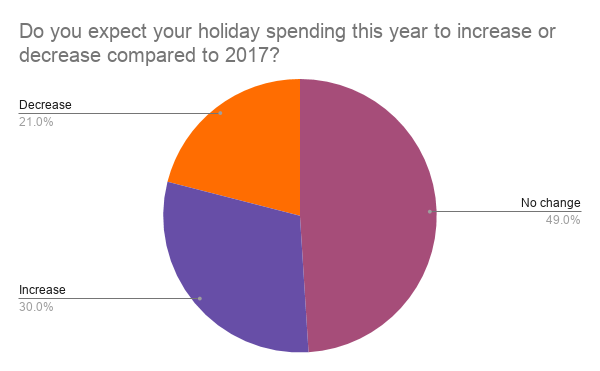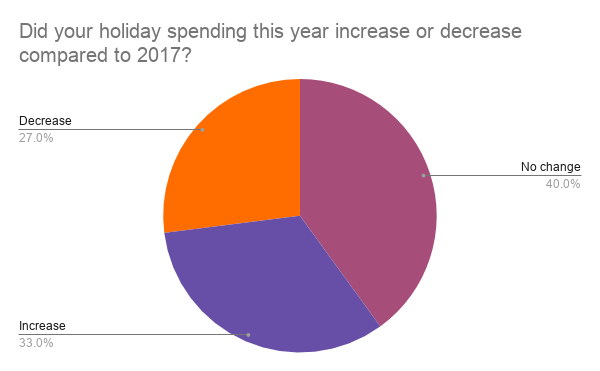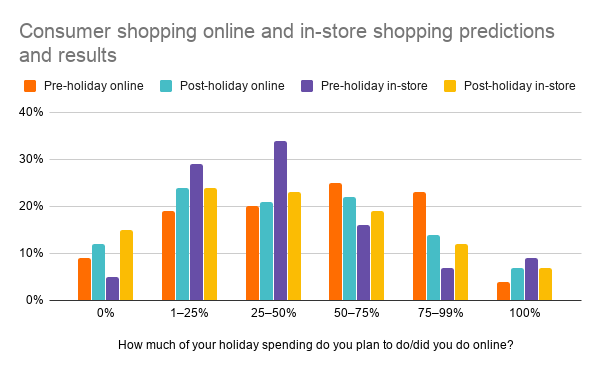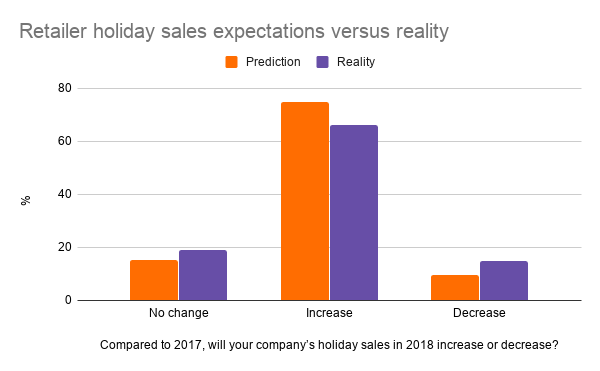Whether you like it or not, the holidays are quickly approaching.
Yes, it’s only September, but next thing you know it’ll be Halloween, then Thanksgiving, then Black Friday. If you’re a retailer, you’re already working hard strategizing for the holiday season.
Retailers are looking for any and all tips for success with the looming retail apocalypse in mind. For many retailers, improved technology and creating an online presence is the answer; that’s easy to say but less easy to do. 2018 was a banner year for holiday sales, and retailers are hoping to catch lightning in a bottle again.
We wanted to see how retailers are succeeding, particularly what tech they’re using, so we conducted two surveys: one before the holidays and one after to see how retailers were preparing and how that preparation paid off. We compared how much retailers and customers rely on e-commerce or brick-and-mortar stores for their holiday shopping, and how technology is helping retailers drive revenue during the holidays. The surveys compared expectations to results. How did people feel going into the holidays? How did things actually play out?
We polled 400 people for each survey; 300 were retail professionals and 100 were retail consumers.
Consumer survey results
In general, respondents’ spending predictions aligned closely with the outcome.
 Despite soaring holiday sales, retail sales fell 1.2 percent in Dec. 2018. Our data concurred with this, since more respondents decreased their holiday spending than they predicted. While the largest segment didn’t change their spending at all, fewer respondents did not change their spending than predicted.
Despite soaring holiday sales, retail sales fell 1.2 percent in Dec. 2018. Our data concurred with this, since more respondents decreased their holiday spending than they predicted. While the largest segment didn’t change their spending at all, fewer respondents did not change their spending than predicted.

According to our surveys, 52% of respondents anticipated doing at least half of their shopping online, but only 43% did at least half of their shopping online. This could imply people are doing less shopping than planned, but could also mean that people are not relying on online shopping as much as they anticipated. Notably, 4% planned to do all their shopping online, but 7% did all their shopping online. For stores, this shows that providing an online store is important for customers, but traditional brick-and-mortar stores are not in immediate danger.
However, 68% of respondents planned to do less than half of their shopping in stores, however 62% did less than half of their shopping in stores, reinforcing that most people anticipated doing most of their shopping online. The difference between the planned and actual amount of people who did no shopping in stores is significant: 5% planned to do no shopping in stores, but 15% did no shopping in stores.
This data reinforces that online retail is a strong force gaining strides against traditional storefronts. Retailers should note how many people expect to do at least a portion of their shopping online. A store with a strong online presence and e-commerce offerings can capture consumers looking for both an online and a storefront experience.

Retailer survey results
Retailers were optimistic about sales in 2018, but the reality was slightly different. More retailers predicted increased sales than actually occurred, and fewer retailers predicted a decrease than actually occurred. Although sales were the highest they’ve ever been overall, the reality was not as impressive as the predictions.
 We expected retailers to lean on e-commerce sales during the holidays, but it was surprising how few predicted a large portion of sales would come from their e-commerce channels. In reality, there were more retailers who made 75-100% of their revenue via e-commerce than predicted. When it came to using technology to handle the holiday rush, 48% of companies used POS software, 41% used retail management systems, 36% used inventory control, and 35% used employee scheduling. So even if companies aren’t relying on e-commerce to improve their holiday revenue, they are utilizing other business technology. These tools are generally flexible enough to handle the increased traffic.
We expected retailers to lean on e-commerce sales during the holidays, but it was surprising how few predicted a large portion of sales would come from their e-commerce channels. In reality, there were more retailers who made 75-100% of their revenue via e-commerce than predicted. When it came to using technology to handle the holiday rush, 48% of companies used POS software, 41% used retail management systems, 36% used inventory control, and 35% used employee scheduling. So even if companies aren’t relying on e-commerce to improve their holiday revenue, they are utilizing other business technology. These tools are generally flexible enough to handle the increased traffic.

We asked if respondents were happy with their e-commerce platform (provided they use one). We wondered if part of the reason retailers seem reticent to rely on technology is its performance. The vast majority are either satisfied or very satisfied with their e-commerce platform both before and after the holidays, but 27% predicted somewhat or not satisfied with their e-commerce platform, while only 16% reported being somewhat or not satisfied. It seems that the technology itself is not the blocker here. In most cases, the issue ends up being a website crash, not necessarily the e-commerce platform’s fault.
Looking forward
Last year was disappointing despite its record-breaking numbers. This year, there are a variety of factors that may contribute to another strong year, or start a downward trajectory. We’re creating another set of surveys to measure retailers’ holiday predictions with their results.
By utilizing software, retailers can gain insight into how their business is performing, where they can improve, and simplify tedious tasks. While e-commerce is an extremely important channel to utilize, there are a variety of technologies available to improve brick-and-mortar operations. We’d love to know more about what technology businesses are using and how, and how it impacts their bottom line. We’ll be publishing more blogs digging into this data in the coming weeks to help prepare you for the 2019 holiday season.
Data is power, help us collect more so you can make smart software decisions.

Lauren Fram
Lauren is a former market research analyst focusing on the e-commerce and retail industries. Since joining G2 in July 2017, she has focused her energy on consumer-driven spaces after spending time in the vertical, design, and CAD software spheres. She graduated from the University of Chicago with a degree in English language and literature and her writing and research has been cited in publications such as Forbes, Eater, and Nasdaq.com, among others. She enjoys building and sharing her knowledge, and in her free time enjoys reading, knitting, and gaming. Her coverage areas include retail technology, e-commerce, and restaurant technology.
